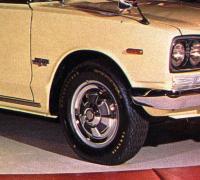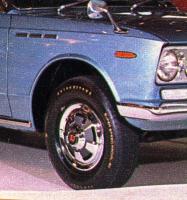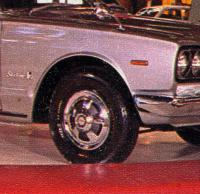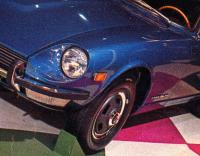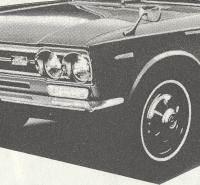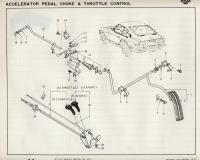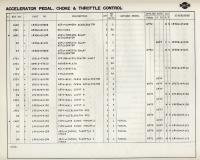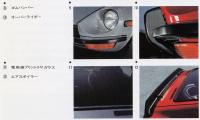Everything posted by HS30-H
-
Well, I wound up with another low VIN Z...
What a lovely honest car. Love it! Congrats.
-
4 errr, 3 matching series 1 caps on ebay
Yes, I agree that the slots are different sizes. The overall design is - perhaps almost remarkably - similar though, don't you think? If a designer had been given a clean sheet of paper on which to design a hubcap for a range of variants in a new model series of cars that would be making a public debut in late 1969, I would have expected him to come up with something that looked - can we say - perhaps a little more different from the '68 Laurel and early '69 Skyline hubcaps? Instead, the cars ended up with with something very similar, also made by IKI. Is that a fair comment, do you think? My point being that - with all the cost constraints, and necessity to keep things simple - I think the cars ended up with what is essentially a modified version of an IKI hubcap that already existed....... It was Matsuo san himself who planted the seeds of all this in my mind in the first place! I was discussing the question of wheels with him ( actually, it started off on a discussion about tyres..... ) and he told me that he really wanted the Z ( meaning all variants, I believe ) to have attractive alloy wheels that were in keeping with the sporty image of the car, but this was stymied due to cost. He told me that he and his team also aimed at a more attractive steel wheel design that did not require a hubcap ( I presume that this would be something along the lines of the four-spoked and multi-hole designs that we can see on some of the clay mockup and prototype photos ) but this too was ruled out. I don't believe that the plain and workmanlike TOPY wheels, covered by the IKI hubcaps, were what he originally had in mind at all. Point of order here if I may; What we are calling the "D caps" ( as seen on the final production Export cars ) are essentially - at least as far as I can see - the same basic pressing as the 'Deluxe' / 'Z-L' model domestic items, but with a different centre 'ornament'. Of course, the domestic ornament did not have a 'D' for Datsun on it - so I find it hard to call the domestic version a 'D' cap. Hope you take the point in the spirit in which it is intended. While I had the scanner fired up and Photoshop running, I'd thought I'd show some comparison shots of hubcaps all in the same place and on the same day, with the possibility that they could be considered as further food for thought. In this particular case the place is the October 1969 Tokyo Auto Show, and the cars are, from the left: *C10-series Skyline 1800DX *C30-series Laurel 'D' *C10-series Skyline 2000GT *S30-series "Fairlady Z Export Version" Datsun 240Z *S30-series Fairlady Z-L
-
4 errr, 3 matching series 1 caps on ebay
Pics as supporting evidence. From the left: *C30-series Laurel - 1800 DX model - October 1968 *C30-series Laurel - 2000DX model - February 1969 *C10-series Skyline - 2000GT 4-door model - February 1969 *C10-series Skyline - 2000GT-X model - February 1970 I'd say that the pressing itself looks pretty much the same all the way through the late '68 through early 1970 period, with the difference being in paint finish / accenting, and of course the different centre emblems. On the '69 Tokyo show stand, you can see that the hubcaps of the Fairlady Z-L model and what they were calling the 'Fairlady Z Export Model' look to be exactly the same, with the exception of the centre emblems. The tyre valve hole is adjacent to a spoke in both.
-
zg flares and super zg flares
I'd like to be able to help you, but your request is something of a "how long is a piece of string" question....... There are many factors that will get in the way of simple, straight measurements - such as original manufacturer ( mine are factory-made and factory-fitment, but what you source might be a copy, a copy of a copy, or a copy of a copy of a copy...... ) and also fitment position - which is variable. And measuring "level to the ground" is another variable that depends on the ride height of the car being measured. Perhaps the best thing to do would be to talk to your eventual chosen vendor ( especially in the case of the "Super ZG" overfenders - which are not a factory item and therefore could be any size ) and see if they can give you some dimensions that you can work from. Failing that, stump up and buy some - and if they don't work, or can't be made to work by modifying them, then sell 'em. You'll lose a little, but it might be worth trying. Cheers, Alan T.
-
Looking for engine L24-063102
Carl, Gosh, did I hurt your feelings? Sorry about that. Somewhere back in my formative internet forum days I received some very good advice. "Grow a skin!" I was told. As far as my exchanges with you go, I believe you get as good as you give. Along with the fawning and sycophantic comments from your fans you have to expect the odd barbed arrow now and then. And after all these years, yes - I'm still trying to correct you on stuff that we've been through what seems like a hundred times. I've tried polite ( still trying, actually ) but it seems less than effective in your case. If you don't want to be corrected, then don't make the ( deliberate? ) mistakes in the first place. That's really all this is about anyway. Demean others? Huh? Listen Carl, if anyone wants to "write and publish articles" they had better make sure that they are properly researched and well written. I'm still learning about these cars we discuss here - how about you? Judging by your apparent avoidance of any Japanese-sourced information - except perhaps from Kats, whose careful and interesting research has been such a great source of discussion and learning for us all on this forum - and your positive denial of first-hand stories from some of the main protagonists ( look at your performance on that L-series valve cover / engine design thread, where you rudely brushed off the words of the very man who designed the damned things and chose to believe a American advertising slogan instead ) you seem to think you have everything you need. This while you famously - and laughably - dismiss half the story of these cars as "irrelevant". And yet zhome.com is full of mistakes, personal opinion presented as fact and advertising copy promoted to the level of biblical truth. When plain, factual errors are brought to your attention nothing seems to happen. Just last week I was on another forum when a piece of zhome.com 'truthiness' was presented as impressive proof of a particular car's race history, when in fact it was embarrassingly wrong. Wrong year, wrong classification, wrong result. But strangley, painting the result as better than it really was ( funny that ). It's been up there like that for years, misleading and misinforming all that read it. About as useful as a typhoid-infected well. For heaven's sake man, WAKE UP!. These are Japanese cars we are discussing here. You seem to somehow fear and deny this, and that crass quote you so often wheel out ( "An American Car, Made in Japan" ) serves only to make you feel less guilty, and others to be misled. My pointers toward the Japanese side of the story will always be dwarfed by your efforts to persuade everyone that they should ignore it. Meeeeowwww! Never mind my Japanese, it looks like you are still struggling with English......... The difference between you and I is that I positively seek out all data and history on the subjects that I am interested in, and I realise and accept that - for the story surrounding a Japanese car - much of this is going to be written or recorded in Japanese. That presents a challenge of course, but at least I'm looking. Would you prefer to believe that understanding ancient Egypt did not require the transliteration of hieroglyphics, or would you strive like Champollion, Akerblad and Young to found out what they actually said? You confuse the message with the medium. If I respond to your mistakes and bad information in a way that you take exception to ( yes, look at THIS THREAD for example ) then take more care to get it right in future. If you don't make the mistakes then I'll have nothing to pick you up on, and we'll all be happy and better informed. You respond to my points of correction in this thread by completely ignoring the points that have been made, and going off on a tangent. But Carl, it's not me that you need to defend yourself from. All you need to do is broaden your view to include the things that you have sa far taken great pains to ignore, and to accept that the Japanese market cars - and all the other Export market cars - are just as much a part of the story of 'your' cars as anything else. That's not my truth, it belongs to all of us who share an interest in the concept, design, engineering and production of these cars. moonpup = Beck lapdog. Characteristic brown nose Respectfully, yours etc. Alan T.
-
Looking for engine L24-063102
Ha ha ha "Mr Pot, meet Mr Kettle...." Carl, I'd take you a lot more seriously on this subject if I thought you you knew what such a tag was called in Japan when the car was being made. You know, that far away country that existed solely to make Zs for the USA and ( sometimes ) Canada. Of course, we all use the convenient label of "VIN tag" when we are talking about this stuff because we are all trying to talk about the same thing and minimise the confusion. It's just vernacular, and as long as everyone realises what is being discussed, and that the subject is something of a moving target ( with regional market and familial model differences ) then all should be well. Just like when you talk about the "door jam tag", but I know you actually mean 'door jamb tag'. *Unless there's an obscure flavour of jam that I have never heard of......... Groundhog day again, I see. I have pointed this out to you on this forum many times, but it just never seems to sink in. Maybe it is because you think the Japanese market cars ( or at least some of them? ) are "irrelevant", or maybe you just have trouble remembering, but NOW HEAR THIS: "First Generation" Japanese market S30-series Zs do not have their engine block number stamped anywhere on the car except on the engine block itself. Print that out and hang it on the wall of your garage if you have trouble remembering it. Nope. What we can call "the VIN" ( I'll use 'Shatai Bango' for my cars, thanks ) does not contain anything more than a clue to the "Model Information". Does it differentiate between a north American market 'HLS30' prefixed car and an 'HLS30' prefixed Swiss market car? No. Does it differentiate between a domestic market 'HS30' prefixed Fairlady 240ZG and an Australian market 'HS30' prefixed 'Datsun 240Z'? No, it does not. Does it differentiate between an 'S30' prefixed Fairlady Z and an 'S30' prefixed Fairlady Z-L? Shall I go on? If you find it impossible to think of The Big Picture when it comes to this family of S30-series Z models, then I sincerely hope that others will see what you are doing and recognise it for the short-sightedness that it is. As something of a revered 'oracle' in the English language early-Z interweb ether, you need to be extra careful of what you write. Can't have a shepherd that leads his flock over the edge of a cliff, can we? Cordially, yours etc. Alan T.
-
RHD 1972 Carb linkage
No, it's a little bit more complicated than that. The 'Bell Crank' and 'Bell Crank Bracket' in particular are completely different between RHD and LHD versions. Hopefully they will still be attached to his '72 RHD car, so he won't have to source or fabricate them. The ball-jointed actuating rod that sits parallel to the firewall is very long on the RHD, but if that is missing it would be fairly easy to replicate.
-
RHD 1972 Carb linkage
Take a look at the attached scans, which are taken from the 1972 RHD Export market factory parts list. They should give you a pretty good idea of what you have and don't have, I hope. You don't say exactly what model of S30-series Z you have ( a 1972 Japanese market car could be any one of six different model variants ) or what kind of condition it is in, so there's no way for us to tell you what you need to source. If you need any more help, then perhaps give a few more details? I don't own any Datsuns. I own four Nissans and an Audi.
-
RHD 1972 Carb linkage
I'm willing to help you in any way that I can ( I have three Japanese market S30-series Z cars ) but I'd prefer to do it here on the forum rather than in direct e-mails to you. That's what the forum is for....... You say you already have a Japanese market car, and a set of Hitachi-licensed 'SU' carbs - so you should already have most of what you need. What is missing from the base car? The stock linkage is quite simple, so you should be able to fabricate anything that is missing. What do you need?
-
Rally Clock for sale on Ebay
I'm getting very strong feelings of deja vu here. I think I've heard this sales pitch story before...... It is certainly possible that PS30-00031 could have been made by 10/69, as Nissan made 72 PS30-prefixed cars before the end of 1969. However, I don't think this seller owned a Fairlady Z432 and I don't think that there is one in Germany now either....... If the car that he took the clock from still exists, then why did he take the clock out, and what went into the hole that it left? Maybe a
-
What is the Correct Early Series 1 Rim Size
One of the Nissan 'Sports Options' lists for the HS30 includes pressed steel wheels sized 5.5j x 14, and with part number 40300-E4200. I would have thought these would be identical to that E4600 version? I wonder why the different part number? Interestingly, the same list includes pressed steel ( 'street' ) wheels sized 8j x 14, with part number 40300-E7200. They are quoted at zero offset, and are notably different to the magnesium eight-spoke Kobe Seiko ( 'race' ) wheels also sized at 8j x 14 and zero offset that are below them on the same list. 10j x 14 magnesium KS eight-spokes were also listed. I saw some wide Topy steels ( the 8j I think ) on an early Fairlady Z in Japan some years ago. I'm sure I took some photos of it........
-
Flat black hood
Heat dissipation was certainly one concern on the Japanese race cars, but that 'look' became de rigeur at some unidentifiable point. Fashion following on from function I suspect. A big point that I didn't note in that original post was that the Works rally cars in particular had flat / satin black-painted bonnets ( hoods ) and wing ( fender ) tops to prevent reflected light from blinding the driver and navigator...... Driving in rally events - often in seasons and locations where the sun is low in the sky all day - at times of day where the sun is likely to be right in your eyes, can be downright dangerous. Sudden reflected sun glare when travelling at 140kph down a gravel road lined by trees and piles of logs, can be buttock-clenchingly surprising! During the late Sixties and early Seventies it was the 'done thing' to prep the cars this way. I don't see it on modern WRC cars, and I guess that it might have fallen out of fashion to some extent - even though the same phenomenon must be encountered. Maybe they have non-reflective sponsor's stickers and polaroid windscreens or something?!
-
How to visually ID a FS5C71-A transmission?
I have four or five FS5C71A gearboxes in my garages. If you need any detail photos I could possibly drag one out into the light tomorrow and pop some shots of it. These illustrations ( especially the 4 to 5 speed 'A-type' box comparison ) might be useful too, I hope:
-
Datsun-240z Vs Fairlady-z432
I assume you are referring to the 'USA & Canada Parts Catalog'? In which case, what was the part number for the USA & Canada market front bumper without the rubber hole that was used before 06/70? All I see in my copy of the USA & Canada parts list is 62650-E4101 ASSY-FRONT BUMPER with an applied date up to 05/70, and the 62650-E4103 listed as an 'Op' part ( with that 06/70 'Applied From' date ). If 62650-E4101 was used up to 05/70 in the USA & Canada, and came with the corner rubbers and ( obviously ) the holes, then it would suggest that the part numbers are not corresponding - viz: In the Japanese market parts lists, 62650-E4101 is listed as the bumper used on the 'S' model ( meaning 'S30-S', or 'ZStd', or simply 'Z-S' - the no-frills 'Fairlady Z' ) which had plain, non-rubbered bumpers ( obviously ) without the holes. This plain bumper was also used on the 'PZR' 'Fairlady Z432-R. 62650-E4100 is of course the rubber-trimmed bumper used on the 'Deluxe' model 'S30' 'Fairlady Z-L', and the 'PZ' model 'PS30' 'Fairlady Z432'. I don't see 62650-E4100 listed in my copy of the USA & Canada parts lists.
-
Skyline 3.0 Liter L6 Valve Cover?
Have a peep at post #41 on this thread: http://www.classiczcars.com/forums/showthread.php?t=20795
-
Datsun-240z Vs Fairlady-z432
Excuse me for this short diversion to the thread.... Carl, I've seen you do this before, and I find it hard to understand where it comes from (?). Abbreviating 'Nissan Shatai Koki K.K.' or 'Nissan Shatai' to just "Shatai" makes no sense whatsoever. It's like abbreviating 'Fisher Body Co.' to just "Body". For the sake of clarity, I suggest we here all agree to call the company that actually built the cars we are talking about 'Nissan Shatai'. Agreed? :classic: Apologies for the diversion. Cheers, Alan T.
-
"D" Cap Stamped Number
Yeah, let's not bring anything not sold in the USA into the discussion.
-
"D" Cap Stamped Number
Yes, They were used on certain models in the C10-series Skyline range - from August 1968 onwards, and on certain models in the C30-series Laurel range - from April 1968 onwards. Here's a pic of some Skyline versions:
-
What's the earliest Auto Z?
Well, given as you have often said that the Japanese market cars were/are "irrelevant", I would have thought it would be all too easy for you to miss it..........
-
Rear Spoiler
Montezuma, Just to clarify the term: "PZR" was factory internal vernacular for the PS30-SB 'Fairlady-Z 432R' models ( "PZ" was PS30 'Fairlady-Z 432', "ZS" was S30-S 'Fairlady-Z', "ZDX" was S30 'Fairlady-ZL', etc etc ) so you could feasibly call that style of rear spoiler - especially if you sourced it direct from Japan - either "PZR" or "432R" style. It seems logical to me to use the term that identifies the source or root of the original design, or which at least points to where it came from. Everybody is of course quite free to call them what they want. However, in my opinion it seems better to make that choice after you have had all the appropriate and relevant information placed before you. I'm sure you would agree Alan T.
-
Rear Spoiler
I'm stepping back up onto the old hamster wheel again...... What everybody usually calls the "BRE" rear spoiler, and what others ( as seen in this thread.... ) call the "432" rear spoiler - that's the one usually identified by the vertical ribs on its front face - would be more accurately described as the '432R' rear spoiler. This item was first seen at the press preview event held at Nissan's Ginza, Tokyo showroom on October 18th 1969, and was mounted on the PS30-SB model 'Fairlady-Z 432R' that was on display there. This model was a purpose-built homologation special, constructed and made available to the general public in very small numbers in order to legalise the model for Japanese GT racing. Nissan only needed to make 25 cars in order to qualify for the JAF GT class - so that's what they did. This rear spoiler also made it into the JAF homologation papers for the 'Fairlady-Z 432' ( NB - this is NOT the '432R' ) and 'Fairlady Z/Z-L', and also the JAF / FIA 3023 papers for the Export model 240Zs. This "PZR" rear spoiler was also included in the standard showroom model options lists for the other current Japanese domestic models of that period ( November 1969 through October 1971 ). It could be optioned at time of order, and was sometimes fitted by the dealer supplying the car to the customer. We could call it a standard Japanese extra-cost option for all models, but in Japan it is more commonly known as the '432R' rear spoiler, because that is the model that it is identified as having originated from. To sum up, this spoiler was standard equipment on the PS30-SB model 'Fairlady-Z 432-R', but was offered as an extra cost showroom catalogue option for the other models. You're a couple of years out, Carl. In October 1971 - with the introduction of the L24-engined models to the Japanese market lineup - the new 'smooth' rear spoiler ( without the distinctive vertical ribs of the 'PZR' spoiler ) was offered as an option across all Japanese market models. As far as I am aware, the ribs were deleted from the new design as they held water between them when it rained, and this water would flood across the window and into the gap between the tailgate and roof panel when the tailgate was raised......... You seem to have managed to make it sound as though Nissan 'copied' the BRE design for the 'smooth' spoiler. I'd say the opposite is far more likely. There is an illustration and instructions / dimensions for mounting of the later 'smooth' spoiler in the October 1971 factory service manual for the HS30, PS30 and S30 models. These are the exact same dimensions as the six mounting studs on the OEM early 'PZR' type ribbed rear spoiler that I sourced from Japan for my 432R replica project, and they correspond with the mounting holes for the standard smooth rear spoiler seen on all the UK export market cars. Photos: 1969 Japanese market options list, 1971 Japanese market options list close-up, and October 1971 Japanese market FSM page scan:
-
Walter Mitty Historic Races
Sad to hear that Mike Cammarata has passed away....... Carl, I notice that you have updated the page on zhome.com ( it actually says "as of 24th Nov. 2008"........ so perhaps a little bit of a typo there? ) and included the page from Vintage Motorsport magazine, which also contains some errors. Since my first contact with Mike Cammarata about his car, I carried on with researching the car and driver on the Japanese side - and I have uncovered quite a lot of new data, including race reports and photos of the car in action. I'd be happy to make this available to anyone who buys the car, and wants to dig a bit deeper into the story. It's a very interesting story, and does not need to be embellished with exaggerations, misinformation and ill-informed guesses. It stands up on its own without any of that. Alan T.
-
Blue engine paint
Hi Kats, I get the impression that the gentlemen at Maruyama would have painted their S20 engine blocks any colour except Nissan's blue, as a matter of policy. The S20's water pump pulley is the ( Austin ) Nissan blue though........ :classic: Well, he is a Volkswagen dealer. I think that might have something to do with it........... Alan T.
-
Blue engine paint
Nissan's blue engine paint has Austin DNA. Back in the 1950s, when Nissan were assembling CKD kits of Austin cars, they were given a 'British Standard' paint code for the formulation of the engine block and ancillaries colour. It seems to have stuck. This colour is still listed on the 'British Standard' database as B.S. 18C39, with HMG ( Her Majesty's Government ) number GL31557, and 'Glidden Number' name 'Dolphin'. Alan T.
-
Metal 240z Emblems/Badges?
Interestingly, the 'FairladyZ' and 'Fairlady' script emblems - and the 'Z' bonnet / hood emblem - seen on the Japanese market cars continued to be made from die-cast mazak well past 1973. When the L24-engined Japanese market models debuted in late 1971, their mazak 'Fairlady' script emblems were paired with the injection moulded plastic '240Z' emblems that were seen on the Export market cars. A metal emblem and a plastic emblem side by side...........





